Nov 11, 2021
Antarctica’s Coldest Half-Year Since Measurements Began 60 Years Ago
Temperature Bottom Falling Out: Antarctica’s Coldest Half-Year Since Measurements Began 60 Years Ago
By P Gosselin on 9. November 2021
Antarctica sets a record cold six month period...Neumayer station sets new winter record low, sees rapid cooling since 2000!
German Die kalte Sonne here features Antarctica’s record cold winter - the coldest since temperature measurements began some 60 years ago.
Coldest April-September period
The Amundsen Scott station at the South Pole recorded a mean temperature of -60.9C for the April 1 to September 30 period, according to the US National Snow and Ice Data Center (NSIDC). For the June-July-August period, the mean was minus 62.9C the second coldest recorded.
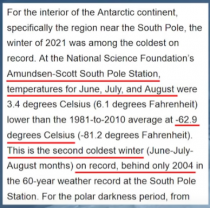
Enlarged
Image: Die kalte Sonne.
Apparently the 140 or so ppm added CO2 couldn’t trap enough heat to prevent a record cold from being set. The previous record for June-July-August was set in 2004.
Neumayer sets record cold, sees 3C of cooling since 1985.
Die kalte Sonne reports that a record was also set at the German Neumayer Antarctic station, located on the Antarctic coast, which saw a mean June-July-August temperature of -28.6C.
Recording at the Neumayer station began in 1985, and the linear trend over the past 35 years has fallen by almost 3C! It’s been cooling even faster since 2000:
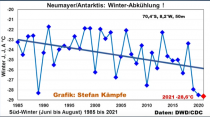
Enlarged
Rapidly cooling Antarctic. Chart: Stephan Kampfe. Data: DWD.
The German Neumayer Antarctic station has seen a distinct cooling trend since 1985, according to data from the German DWD national weather service. This is not getting reported by the media in Germany in any way, shape or form. We can just imagine the blaring headlines if the trend instead had shown 3C of warming. You’d have a thousand German journalists descending on the South Pole by now.
Record warm reading gets discarded
Last February, for example, the German Berliner Morgenpost reported how for the first time the temperature had climbed over 20C at the northern tip of the Antarctic peninsula - Seymour Island. “At the South Pole, climate change is very clear,” declared the Morgenpost.
However a subsequent World Meteorological Organization (WMO) investigation found the reading had in fact nothing to do with climate change, Die kalte Sonne reports:

Enlarged
Image: Die kalte Sonne.
The 20.75C “record” reading resulted from a faulty instrument, and thus was nullified last July.
Yet, activist groups like Germany’s DUH don’t want to hear any of it. They continue to cite the nullified record even today for gathering petition signatures.
Oct 31, 2021
Developments in climate change science
Alan Moran, Director of AEF -
Delving into the latest IPCC report, Judith Curry finds this projection to 2035, at which time the “running hot” models are projecting temperature levels between almost the same as today and a little over 0.5C warmer.

Enlarged
Richard Lindzen notes that global temperatures have increased 0.5C since 1960, noting “Despite the fact that increases of CO₂ thus far have been accompanied by the greatest increase in human welfare in history, and despite the fact that there have been large increases in the Earth’s vegetated area largely due to increases in CO₂’s role in photosynthesis, governments seem to have concluded that another 0.5 C will spell doom”.
Blogger Geoff Derrick distills the following chart of recent global temperatures from the UK Met Office Hadley Centre showing no warming since 2014.

Enlarged
-----------
Icecap Editor Note:
The best data shows no warming this century.
See the Climate Reference Network plot of Monthly Average US temperatures since inception in 2005 and the constructed data from the US climate divisions back to 1998’s super El Nino.

Enlarged

Enlarged
And the average monthly maximum temperatures for the US climate divisions.

Enlarged
See much more detail on the true temperature story here.
Please share freely. Help us get the word out with a secure Paypal donation (left column home page).
------------
Roger Pielke condemns UN Secretary-General Guterres for wrongly and irresponsibly calling the latest IPCC report a “code red for humanity”. The report claims that heatwaves and extreme precipitation will be more frequent but not floods, hail, lightning, hurricanes, strong winds and droughts.
The Observer Research Foundation (an organization partnered by Apple, Bill Gates, Uber, Google, and Microsoft) says climate change threatens India’s food security. That assumes Indian agriculture is highly vulnerable to climate disasters. But India’s agricultural output is at record levels, and projected to grow due to increased rains from warming oceans.
Having called out “scientists” inventing a global warming-induced collapse of the Great Barrier Reef, Dr Peter Ridd was subsequently sacked from his James Cook University position for disloyalty. The High Court found provisions in university codes of conduct that seek to prohibit robust, aggressive and acrimonious debate are inconsistent with intellectual freedom. Ludicrously, the Court also concluded that Dr Ridd should have followed University’s confidentiality directions but to have done so would have made it impossible for him to contest the case. Parliament is to pass laws clarifying intellectual freedom.
Developments in climate change economics
In response to massive energy price hikes in Europe, Frans Timmermans, the EU’s climate chief, adopting the ostrich approach, says the solution is more renewables, not fewer. US Treasury Secretary Janet Yellen says the answer is storage but omitted to say what the cost would be. Eric Worrall has put a $50 trillion price tag on batteries that would allow just 5 days storage in a wind drought.
UK Energy Secretary, Mr Kwarteng claimed that despite the shift from coal to renewable energy in the last ten years “the costs haven’t gone up”. But the Office for Budget Responsibility (OBR) says subsidies to renewables now add 10 billion pounds a year to electricity consumer costs, even excluding all the increased system management and grid expansion costs. While Boris Johnson claims the UK will achieve net zero without “a hairshirt in sight” Treasury points to a cost of 60 billion pounds a year by the next decade and, as the Spectator notes, “Government estimates are notoriously inaccurate”. The Daily Mail described Johnson’s eco dream as “the longest suicide note in history”.
UK government has a gas crisis. In pursuing a greenhouse agenda, it has prevented new North Sea developments and has banned fracking of gas in the abundant onshore resources.
Norway’s new left-wing government is, however, not sacrificing its own coal and oil to global concerns as it steps up new drilling.
Ominous for the world, disastrous for Germany: Social Democrats, the Green Party and the Free Democrats join for a “fresh start” and pave the way for an ecologic modernization of the economy that complies with climate targets. Yet, one month after the September election the green coalition is not yet operational with the three parties focussed on higher energy prices.
Bucking the trend, French Presidential hopeful Marine Le Pen, the head of the National Rally (RN) party, has said she would take down France’s wind turbines and end subsidies for renewable energy if she was victorious in next year’s elections.
Edwards, Dobson and Owen estimate that to firm-up intermittent energy in the UK with 50 per cent wind supply and 10 windless days would require 5 TWh of battery storage at a cost 1.5 trillion pounds.
Oct 18, 2021
Introducing David R. Legates, recipient of the 2021 Fredrick Seitz Memorial Award
By Ken Haapala, President, Science and Environmental Policy Project (SEPP)
Introducing David R. Legates, recipient of the 2021 Fredrick Seitz Memorial Award.
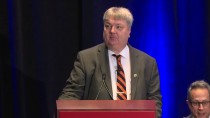
Physical Science develops with the constant conflict between ideas and evidence. What ideas best fit the physical evidence? When the physical evidence changes the ideas must change accordingly. Otherwise, the science becomes stagnant, dogmatic. That is what is happening to the science claimed by the UN Intergovernmental Panel on Climate Change (IPCC) and its followers, including many once noted US science institutions.
In 1988, the UN established the IPCC to (1) assess the scientific information related to changes in climate from emissions of greenhouse gases and 2) formulate realistic responses. The IPCC issued its first report in 1990.
Since then, a great deal has changed including:
1) human conditions have greatly improved thanks to the use of fossil fuels.
2) the physical evidence of what is happening in the atmosphere with increasing CO2 has greatly improved
3) the attitudes of Western governments to changing science have worsened
Over the last 30 years, one of the most remarkable changes is the tremendous reduction in people living in extreme poverty. Extreme poverty is defined as person having a local purchasing power of $1.90 a day. It is estimated in local currency and adjusted to inflation and similar issues. The estimates used here come from Our World In Data and were updated in 2019
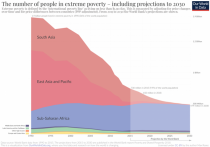
Enlarged
As you see, 30 years ago 1.9 billion people 36% of the world’s population lived in extreme poverty, mostly in Asia. Extreme poverty is life on the edge of death. In 2018, 650 million lived on the edge, about 9% of the world’s population. The great reduction in those living in extreme poverty is despite an increase in population of about 43%.
From 1990 through 2018 the world’s CO2 emissions increased by 60%. China’s CO2 emissions grew by 315%, more than three times. Today, Asia emits more CO2 than all other continents combined.
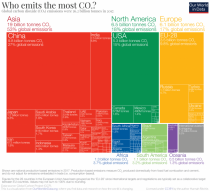
Enlarged
A second remarkable change is Space Age Technology which gives us the ability to observe and measure what is occurring in the atmosphere, where the greenhouse effect occurs. This evidence contradicts that early scientific speculation. Despite a 60% increase the influence of CO2 on global temperatures is modest, and not dangerous.
A third remarkable change is the obstinance of Western Governments and many western science institutions in ignoring the changing evidence. Contrary to the scientific method they are refusing to adjust their views, which they still call scientific, to the great expansion in physical evidence about the atmosphere and the effects of carbon dioxide. With mounting physical evidence, what began as a scientific speculation has drifted into world of science fiction and political myth.
Washington DC is a hotbed for science myths and attacking all who dare question them. Our honoree had already experienced what happens to physicists who challenge the accepted myths with physical evidence. In his experience in estimating precipitation, he always advocated those measurements must be checked and double checked, and when scientific concepts do not meet the evidence from experiments and observations, the concepts must be change. This winter, when given an opportunity he bravely stood up, and with the support of a few, declared certain myths popular in Washington are not science, and explained why.
Ladies and gentlemen, I have the privilege to present to you the honoree of the 2021 Fredrick Seitz Memorial Award, Dr. David Russell Legates
Oct 02, 2021
British Electricity Hit Hard by Wind Failure and Gas Shortage
by Llewellyn King
If you are thinking of going to Europe this winter, you might want to pack your long undies. A sweater or two as well.
Europe is facing its largest energy crisis in decades. Some countries will simply have no gas for heating and electricity production. Others won’t be able to pay for the gas which is available because prices are so high - five times what they were. Much of this is because Russia has severely curtailed the flow of gas into Europe, following on a wind drought.
Things are especially bad in Britain, which has been hit with a trifecta of woes. It started with a huge wind drought in the North Sea, normally one of the windiest places on earth. For the best part of six weeks, there simply wasn’t enough wind, and Britain is heavily invested in wind. Also, it has never installed much gas storage, which is one way of hedging against interruption.
Britain took to decarbonization with passion, confident of its great wind resource in the North Sea, where the wind is measured in degrees of gale force by the Met Office. The notoriously rough sea off Scotland hasn’t been getting its usual blow. Most European countries are 10-percent dependent on wind, but Britain relies on it for 20 percent of its power.
One result has been to propel gas prices into the stratosphere; consequently, the price of electricity has soared. Of 70 British electricity retailers, 30 have failed and others are expected to shut up shop as well. These arent generators but buyers and sellers of power, under a system that had been encouraged by the government when it broke up the state-owned Central Electricity Board during the Thatcher administration.
Britain, which opened the world’s first nuclear power station at Calder Hall in 1956, has been indecisive about new nuclear plants. Those now under construction are being built by Areva, a French company, which is partnering with the Chinese. This has raised questions about Chinese plans for a larger future role in British nuclear at a time when relations have soured with Beijing over Hong Kong and Chinese criticism of Britain’s right to send warships to the South China Sea, which it did in September.
One way or another, the input of electricity from nuclear in Britain has fallen from 26 percent at its peak to 20 percent today.
The biggest contribution to Britain’s problems, and to those of continental Europe, come from Russia limiting the amount of gas flowing into Europe. The supply is down 30 percent this year, and Russia looks set to starve Europe further if this is a cold winter as forecast.
Russia is in open dispute with Ukraine, which depends on Russia’s giant gas company, Gazprom, to supply gas for the Ukraine distribution system to other parts of Europe. At the heart of the Russian gas squeeze is the Nord Stream 2 pipeline, which has been completed but isn’t operating yet. It takes gas directly - 750 miles - to Germany under the Baltic Sea and parallels an older line. Its effect will be to cripple Ukraine as a distributor.
The United States opposed the pipeline, but President Joe Biden reversed that in May. Ukraine feels betrayed, and much of Europe is uneasy.
Going forward, Europe will be more cautious of Russian supplies and less confident that the wind will always blow. Its Russian gas shortage has put pressure on international liquified natural gas markets, and counties are hurting from China to Brazil.
Britain has a separate crisis when it comes to gasoline, called petrol in the United Kingdom: There is an acute shortage of tanker drivers to get the fuel, which is plentiful, from Britain’s refineries to the pumps. British service stations are out of fuel or facing long lines of unhappy motorists.
This problem goes back to Brexit. Driving tankers is a hard, poorly paid job - as is much road haulage - and Britons have stopped doing it. The average age of British drivers is 56 and many are retiring.
The slack was taken up by eastern Europeans when Britain was part of the European Union. But after Brexit, these drivers were sent home as they no longer had the right to work in Britain.
So, the electricity and gas shortages are compounded by a gasoline shortage, which is quite a separate issue but adds to Britain’s woes as a winter of discontent looms.
About the Author
Llewellyn King is executive producer and host of “White House Chronicle” on PBS. His email is llewellynking1@gmail.com. He wrote this for InsideSources.com
See the states that have gone down the carbon taxes or green alternatives fastest.
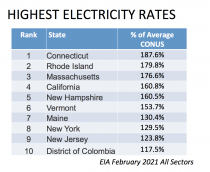
Enlarged
----------
Britain’s fragile electricity system is a national embarrassment and a warning to the world
London, 7 September
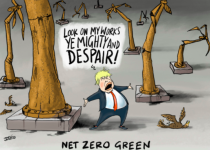
Yesterday, National Grid, the Electricity System Operator, was forced to paid over 20m pounds to “balance” the system and avoid blackouts, ten times more than normal.
The entire UK wind fleet was in effect completely absent for much of the day, only rising above a few percent of its theoretical output late in the day when the crisis was over.
As a result, conventional gas-and coal-fired generators had to be fired up. The UK’s creaking grid was therefore effectively being propped up by fossil fuels.
The cost of these actions was very high, with some units being paid as much as 4,000 pounds per megawatt hour to switch on, an exceptional price by any standard.
The balancing cost of avoiding blackouts has been increasing rapidly and is expected to hit 1-2 billion pounds this year, burdening consumers with ever more expensive electricity bills.
For a country claiming to be “Powering Past Coal” this is a disgrace. Worse still, in the run up to COP26 it gives the lie to any UK government claim to leadership in the delivery of Net Zero and leaves the Prime Minister no plausible platform from which to urge other countries to decarbonize.
None of this should come as a surprise. Power systems engineers and other analysts have known for decades that wind and solar power would make the UK electricity grid increasingly fragile and extremely costly. However, their warnings were ignored, and the government and the British public are now reaping the whirlwind.
--------
South Pole has the coldest winter on record (since records began in 1957).
Between April and September, a research station sitting on a high plateau in Antarctica, registered an average temperature of minus 78 degrees Fahrenheit (minus 61 degrees Celsius). That’s the coldest temperature recorded since record keeping began in 1957, and about 4.5 F (2.5 C) lower than the most recent 30-year average, according to The Washington Post.
The previous record for the coldest winter was minus 77 F (minus 60.6 C) in 1976, Stefano Di Battista, a journalist wrote on Twitter. The Post learned of this record through Battista, but then confirmed the information with Richard Cullather, a research scientist at NASA’s Global Modeling and Assimilation Office.
The frigid winter is likely caused by a strong polar vortex in the stratosphere, the second layer of the planet’s atmosphere from Earth’s surface, according to the Post. “Basically, the winds in the polar stratosphere have been stronger than normal, which is associated with shifting the jet stream toward the pole,” Amy Butler, an atmospheric scientist at NOAA, told the Post. “This keeps the cold air locked up over much of Antarctica.”
What’s more, a strong polar vortex also leads to more ozone depletion in the stratosphere, which strengthens the polar vortex even more, according to the Post. Ozone is a gas made up of three oxygen molecules that is found high in the atmosphere. Ozone protects Earth’s surface from harmful ultraviolet rays and depleting it can expand the ozone hole over Antarctica.
While Antarctica logged the coldest known average winter temperature, satellites have detected individual temperatures that are far lower; as low as minus 144 F (minus 98 C), according to the Post.
Thanks to the frigid temperatures, sea ice levels around Antarctica were at their fifth highest extent on record in August, the Post reported. But the ice melted rapidly over the next several weeks, and by the end of September sea ice had thinned to some of the lowest levels seen at that time of year. Scientists told the Post that the climate in Antarctica is prone to rapid change and that a frigid winter doesn’t mitigate the seriousness of climate change.
Russia Steps In to Fill Demand as Europe Pumps Less Gas
A giant Dutch natural-gas field once pumped enough fuel to cover the current needs of Germany, Europe’s largest economy. Next year, the field is shutting over environmental concerns.
Natural-gas supply shortfalls have led to record prices for the fuel and electricity, stoking fears of a shortage and spotlighting European efforts to cut greenhouse-gas emissions. The conflict is one economies worldwide face as they try to adopt cleaner energy sources.
The European Union taxes carbon emissions to discourage use of fossil fuels and has promoted renewable sources of energy to replace them. Some countries have also targeted production. Denmark has committed to stop pumping oil and gas by 2050. The Netherlands is shutting its vast field, near the town of Groningen, amid public pressure over earthquakes attributed to it. Dutch production cutbacks have left a hole in European output just as demand returns from lockdown-induced lows.
Sep 22, 2021
Shutting Down Genuine Scientific Inquiry
Willie Soon and Ronan Connolly
September 22, 2021
We recently published a new climate change report in the peer-reviewed scientific journal Research in Astronomy and Astrophysics (RAA). The nearly two dozen co-authors of our paper are experts in solar physics and climate science from 14 countries. We were looking at the role of the Sun in climate change. We found that, depending on which scientific datasets you choose, you could explain the global warming since the 19th century as being anything from mostly natural to mostly human-caused. The huge uncertainty over such a key question is a major concern.
A few days after our paper was posted online, the U.N.’s Intergovernmental Panel on Climate Change (IPCC) published their 6th Assessment Report (AR6). The IPCC AR6 concluded that it was “unequivocal” that recent global warming was almost entirely human-caused.
The journalist Alex Newman was struck by the contrast between the two different reports. He interviewed us, representatives for the IPCC, and several other scientists for an article in The Epoch Times.
People began sharing Newman’s article on social media. One of Facebook’s “independent fact-checkers,” Climate Feedback, quickly stepped in. This “fact-checker” website, financially supported by Facebook, TikTok, Google News Initiative, and others, declared the article to be “incorrect” and “misleading.” Facebook then began censoring any posts sharing the link.
When we discovered this, we carried out our own “fact-check fact-check.” Using the “fact-checking” framework developed by Climate Feedback, we found their farcical “fact-check” was guilty of 11 of the 14 classes of misinformation the website warns against, while Newman’s article made none of them.
We wrote an open letter to this supposed “fact-checker” website, asking them to correct their egregious “fact-check.” This can be read at Ceres-Science.com.
However, the almost comical nature of this supposed “fact-check” has prompted us to ask why science reporting is being subjected to “fact-checking” in the first place.
The two assessments on climate change came to different conclusions because they had different goals and used different approaches.
The IPCC was set up by the U.N. Environment Program (UNEP) and the World Meteorological Organization (WMO) to provide “scientific information that [governments] can use to develop climate policies.” We can see what “climate policies” the UNEP have been interested in from a June 30, 1989, AP interview:
“[Director of the New York office of the UNEP, Noel Brown] says entire nations could be wiped off the face of the Earth by rising sea levels if the global warming trend is not reversed by the year 2000. ...He said governments have a 10-year window of opportunity to solve the greenhouse effect before it goes beyond human control.”
The UNEP had already decided, even before the first IPCC report in 1990, that humans were to blame for climate change through their greenhouse gas emissions.
In contrast, our review was written by scientists for scientists. Our approach was to review the areas of scientific disagreement as well as agreement. We tried to describe the full range of scientific opinions - even if they might be politically inconvenient. This is different from the IPCC’s approach of enforcing a “scientific consensus” whenever there is a scientific disagreement.
Both approaches have their pros and cons. Politics works best when everybody agrees with each other. Science works best when scientists are allowed to disagree openly.
Interestingly, the recent obsession with “fact-checking” scientific reporting seems to have begun with climate change. In the early 2000s, some people insisted the IPCC reports offered the definitive “scientific consensus” on climate change. They claimed journalists who applied “balanced reporting” to climate change were creating a “false balance” by implying that the supporters and critics of the IPCC reports were evenly split. As a result, now, many journalists promote this “scientific consensus” narrative by not reporting any findings that disagree with it.
Supporters of this approach call it “reliable reporting,” which sounds impressive. But a better description is “narrative-driven journalism.” Journalists decide on the narrative they believe is “reliable” and then suppress any opposing views.
This “reliable reporting” approach puts a very heavy burden on journalists. They effectively are asked to act as the arbiter of scientific disagreements.
More recently, social media platforms have created a similar burden in their foolhardy quest to quash the sharing of “Fake news.”
“Fact-checkers” claim to provide the solution. But a weaponized “Fact-check” is nothing more than a “narrative-check.”
Science thrives when scientists are allowed to investigate areas of scientific disagreement. So, when journalists and social media platforms use “fact-checkers” to suppress genuine scientific disagreements, they are effectively shutting down scientific inquiry.
Willie Soon, Ph.D., and Ronan Connolly, Ph.D., are the co-authors with 21 other scientists of the peer-reviewed paper titled ”How much has the Sun influenced Northern Hemisphere temperature trends? An ongoing debate.”
Views expressed in this article are the opinions of the author and do not necessarily reflect the views of The Epoch Times.
-------
See another example of the cancel culture in the sciences almost succeeding in eliminating an inconvenient paper here.
|















